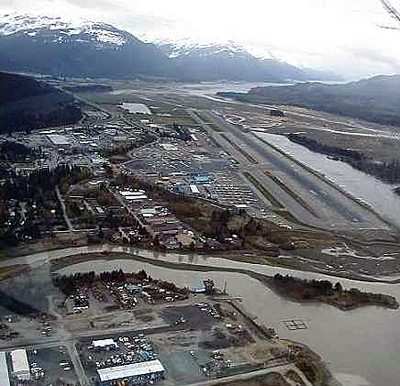Thu, Apr 21, 2005
Alaskan City's Airport Funding Could Be At Stake
The engineered-material arresting system has so far been a
success, saving five aircraft from expensive and perhaps even
deadly mishaps. The crushed material at the end of runways is
designed to slow a speeding aircraft to a stop without causing
severe damage, when they might otherwise run off the end of a
runway and into whatever lies beyond.

So why don't airport officials in Juneau, AK, want to install
it?
So far, 15 airports nationwide have installed the collapsible
cement blocks in runway safety areas that are 1,000 feet long and
500 feet wide. As Juneau International Airport officials
contemplate how to comply with the requirement for a safety area,
they're studying five options -- two of which include an engineered
materials system.
But even though the FAA says it's a proven system, Juneau
International Airport Board Chairman Ron Swanson isn't sure about
EMAS. He's specifically worried about the weather.
"This is untried in Alaska," Swanson told the Juneau Empire.
"There are two major reasons to cause accidents: wind shear and
pilot misjudgment. A standard runway safety area is longer and can
protect the airplanes and its occupants."

Swanson said he's specifically worried about Alaska's bitter
cold in trying to maintain an engineered material safety area. "You
cannot plow snow with a truck on it. This thing would cave in,"
Swanson said. "You have to have special equipment to remove
snow."
The five options are part of the FAA's Environmental Impact
Study, set for release on Monday. While two of the options involve
the new arresting system, two are designed in the traditional sense
and one is a combination of both.
The EIS will be the subject of community hearings in Juneau on
June 1st and 2nd. If airport officials refuse to comply with the
FAA's directives on the subject, they stand to lose their federal
airport grants -- although there's no clear indication that's even
being contemplated at this point.
More News
Aero Linx: The American Society of Aerospace Medicine Specialists (ASAMS) The Society is a non-profit organization created to serve as a voice for and represent the professional ne>[...]
Class C Service This service provides, in addition to basic radar service, approved separation between IFR and VFR aircraft, and sequencing of VFR aircraft, and sequencing of VFR a>[...]
Have A Story That NEEDS To Be Featured On Aero-News? Here’s How To Submit A Story To Our Team Some of the greatest new stories ANN has ever covered have been submitted by our>[...]
Also: ERAU Uses UAVs, P550 Group 2 UAS, Starship’s Florida Launches, NASA Missions Chopped The Air Force has put out a call to commission a one-to-one copy of the Iranian-des>[...]
Classic Klyde Morris From 11.07.16 (and Remembering Bob...) FMI: www.klydemorris.com>[...]
 ANN's Daily Aero-Linx (08.27.25)
ANN's Daily Aero-Linx (08.27.25) ANN's Daily Aero-Term (08.27.25): Class C Service
ANN's Daily Aero-Term (08.27.25): Class C Service ANN FAQ: Submit a News Story!
ANN FAQ: Submit a News Story! Airborne-NextGen 08.26.25: Iran UAV Knockoffs, X-37B Spaceplane, Army Training
Airborne-NextGen 08.26.25: Iran UAV Knockoffs, X-37B Spaceplane, Army Training Classic Klyde Morris (08.25.25)
Classic Klyde Morris (08.25.25)




